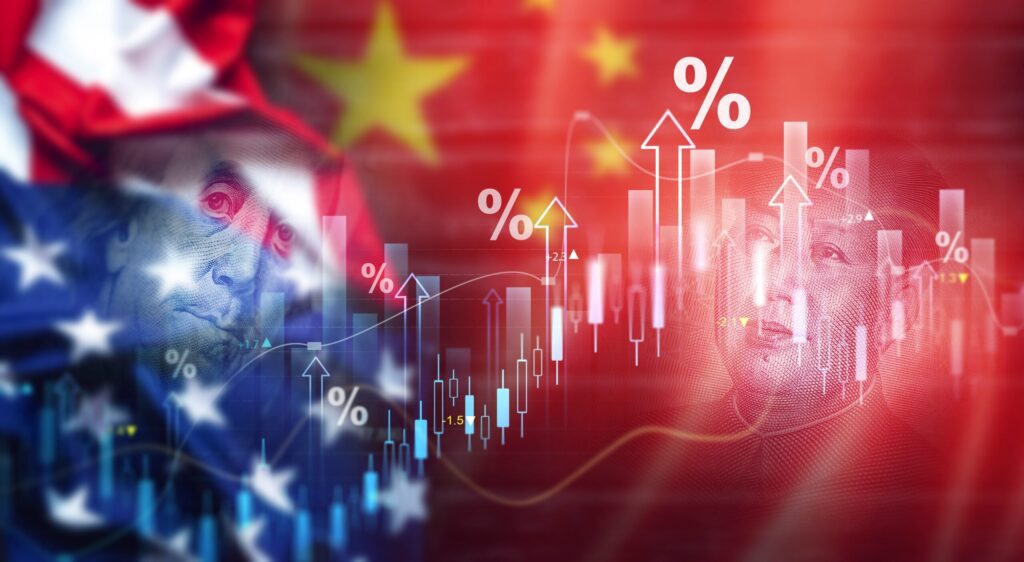Treasury Secretary Scott Bensent and Trade Representative Jamieson Greer have just announced a significant breakthrough in trade talks between the U.S. and China. After a weekend of intense discussions in Geneva, Switzerland, both sides have indicated they’ve agreed to lower tariff levels and implement a 90-day pause to focus on finalising a comprehensive trade deal.
Read also: US vs China: Global Trade: Who’s winning?
This marks a significant step toward a potential free trade agreement between the two economic powerhouses. In 2024, China’s exports to the United States totaled approximately $438.947 billion, while U.S. exports to China amounted to roughly $143.545 billion, resulting in a trade imbalance of -$295.401 billion. This imbalance has been deemed unsustainable, prompting President Trump to seek corrective measures. The core issue revolves around China’s practice of exporting products to the U.S. while allegedly restricting access to its markets for American exporters.
President Trump and his team have demonstrated considerable resolve in addressing this issue, where previous administrations have hesitated. While their approach has introduced market volatility, it appears to be yielding positive results in rebalancing trade.
Recently, the Trump administration finalized a mineral deal with Ukraine, granting American companies the right to extract natural resources. This agreement is poised to be crucial for both energy transition and defense initiatives. The structure ensures that Ukraine retains ownership of its subsoil and maintains final say on extraction activities, while benefiting from the generated revenues. This deal also secures vital access for the U.S. to critical minerals, including graphite, lithium, and rare earth elements, as well as valuable oil, natural gas, gold, and copper reserves.
The second significant deal announced involves the U.S. and the UK. The U.S. has agreed to reduce the import tax on cars, which had been raised to 25% last month, down to 10% for up to 100,000 cars annually. Additionally, a quota has been introduced for steel and aluminum, with the British government reporting a significant reduction in the 25% tariff. The agreement also permits the import of up to 13,000 metric tonnes of beef from each country. Overall, this deal is projected to create a $5 billion opportunity for American exports, including $700 million in ethanol and $250 million in other agricultural products.
Looking ahead, there are potentially more deals in the pipeline, with speculation surrounding possible agreements with India, Japan, and South Korea in the near future.
As previously mentioned, Trump’s approach to rebalancing global trade, characterised by significant disruption, is a strategy few have dared to undertake.
In contrast, the Biden administration focused on strengthening domestic semiconductor chip manufacturing through initiatives such as the CHIPS and Science Act. This act provides funding and incentives aimed at boosting chip production within the U.S., as well as supporting research, workforce development, and investments in new manufacturing facilities. The administration also introduced new tariffs on specific products from China, including wafers, polysilicon, and certain tungsten products critical for solar energy development, with tariffs reaching 50%. While the Biden administration prioritised clean energy, it did not aggressively confront China to rebalance the existing trade deficit between the two countries.
Trump, conversely, directly confronted not only China but also what he termed “offenders” worldwide, asserting that both allies and adversaries had taken advantage of the U.S. This boldness and willingness to challenge established norms could potentially cement his legacy as one of the most impactful presidents of our time, with his instincts, intelligence, determination, and courage reflecting the qualities of a successful businessman and leader.
Returning to the main point, anticipation is building for a new trade agreement with China, and the specifics of this deal are eagerly awaited. The goal is to rebalance the trading system, ensuring fairness and reciprocity, echoing Trump’s principle of “whatever you charge us, we charge you.” I believe in trade deals, but they must be equitable and reciprocal in nature.
The Chinese yuan strengthened to a six-month high this morning following the announcement of an agreement between the U.S. and China to reduce reciprocal tariffs. This development is a positive sign for the global economy, potentially paving the way for a return to normalcy, provided that a fair and equitable deal is established between the U.S. and China to address and eliminate existing imbalances.
The joint statement indicated that, effective May 14, the U.S. would temporarily decrease its tariffs on Chinese goods from 145% to 30%, while China would reduce its tariffs on American imports from 125% to 10%.

